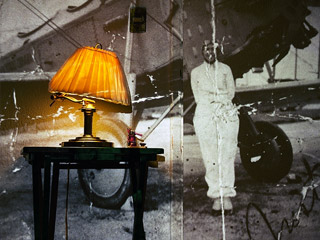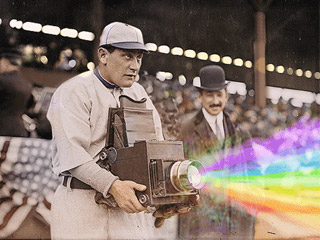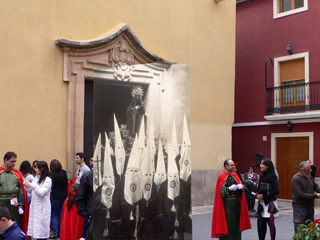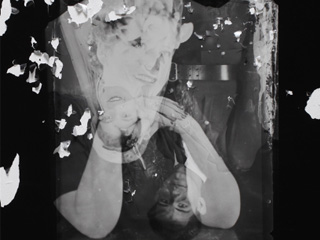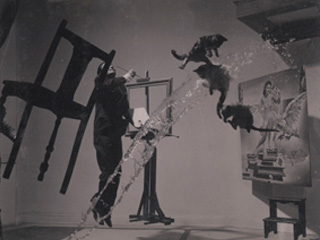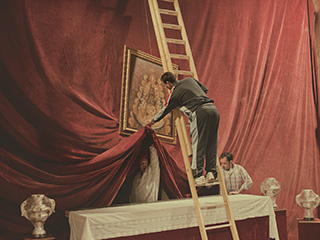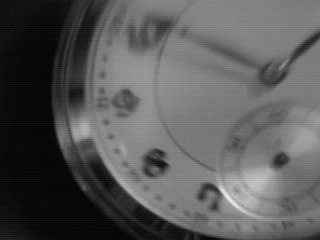ZoneZero
Interview with Eduardo Muñoz. April 2015
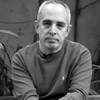 Eduardo Muñoz Ordoqui (Cuba, 1964). Photographer. He received a Bachelor in Fine Arts degree in History of Art from the University of Havana in 1990 and a Master in Fine Arts in Studio Art from the University of Texas at Austin in 2005. He has taught photography for more than nine years in St. Edward’s University at Austin, Texas, where he is currently a Faculty Associate at the Department of Visual Studies. Muñoz-Ordoqui’s photographic work has been exhibited in solo and group shows in Europe, Latin America, China, and United States. He received a John Simon Guggenheim Memorial Foundation Fellowship in 1997, a Cintas Foundation Fellowship in 1998 and in 2007 was chosen for the Artpace International Artist-in-Residence program in San Antonio, Texas, USA. His photographs are held in private and institutional collections in the Americas and Europe.
Eduardo Muñoz Ordoqui (Cuba, 1964). Photographer. He received a Bachelor in Fine Arts degree in History of Art from the University of Havana in 1990 and a Master in Fine Arts in Studio Art from the University of Texas at Austin in 2005. He has taught photography for more than nine years in St. Edward’s University at Austin, Texas, where he is currently a Faculty Associate at the Department of Visual Studies. Muñoz-Ordoqui’s photographic work has been exhibited in solo and group shows in Europe, Latin America, China, and United States. He received a John Simon Guggenheim Memorial Foundation Fellowship in 1997, a Cintas Foundation Fellowship in 1998 and in 2007 was chosen for the Artpace International Artist-in-Residence program in San Antonio, Texas, USA. His photographs are held in private and institutional collections in the Americas and Europe.Interview with Eduardo Muñoz. April 2015
 Eduardo Muñoz Ordoqui (Cuba, 1964). Photographer. He received a Bachelor in Fine Arts degree in History of Art from the University of Havana in 1990 and a Master in Fine Arts in Studio Art from the University of Texas at Austin in 2005. He has taught photography for more than nine years in St. Edward’s University at Austin, Texas, where he is currently a Faculty Associate at the Department of Visual Studies. Muñoz-Ordoqui’s photographic work has been exhibited in solo and group shows in Europe, Latin America, China, and United States. He received a John Simon Guggenheim Memorial Foundation Fellowship in 1997, a Cintas Foundation Fellowship in 1998 and in 2007 was chosen for the Artpace International Artist-in-Residence program in San Antonio, Texas, USA. His photographs are held in private and institutional collections in the Americas and Europe.
Eduardo Muñoz Ordoqui (Cuba, 1964). Photographer. He received a Bachelor in Fine Arts degree in History of Art from the University of Havana in 1990 and a Master in Fine Arts in Studio Art from the University of Texas at Austin in 2005. He has taught photography for more than nine years in St. Edward’s University at Austin, Texas, where he is currently a Faculty Associate at the Department of Visual Studies. Muñoz-Ordoqui’s photographic work has been exhibited in solo and group shows in Europe, Latin America, China, and United States. He received a John Simon Guggenheim Memorial Foundation Fellowship in 1997, a Cintas Foundation Fellowship in 1998 and in 2007 was chosen for the Artpace International Artist-in-Residence program in San Antonio, Texas, USA. His photographs are held in private and institutional collections in the Americas and Europe.Kevin Weir
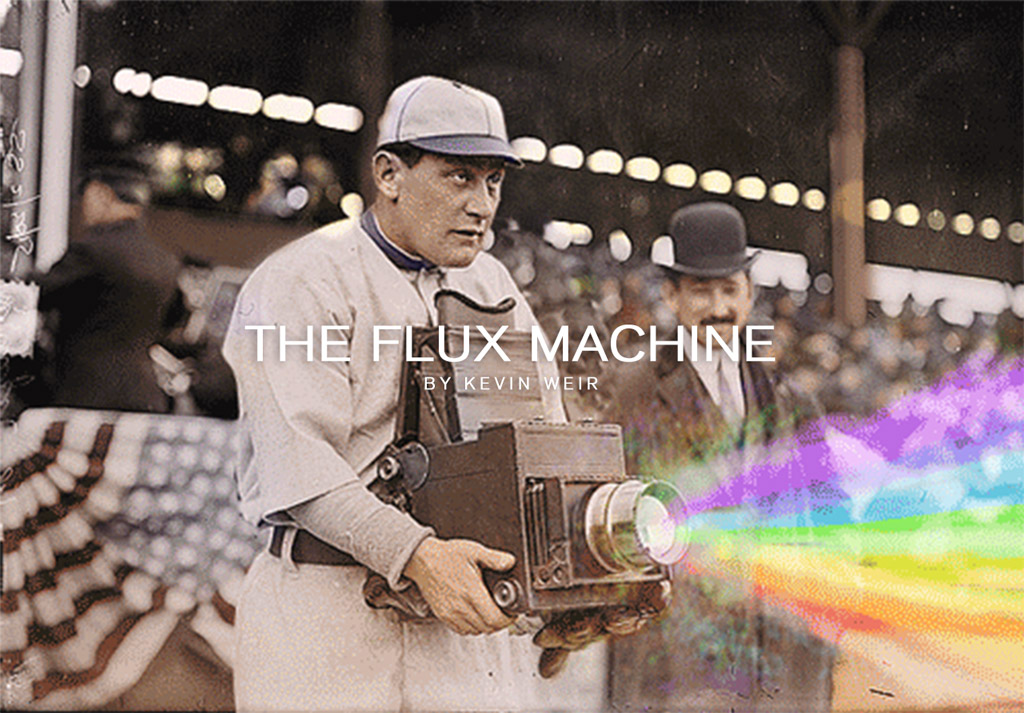






















Kevin Weir’s Flux Machine swivels between two lines closely related to the theme of temporality: using the format of animated GIF, he gives static images infinite and recurrent movement, and integrating narrative elements into archival photographs he reinterprets its meaning. The resulting microfictions offer readings at different levels questioning our usual interpretation of archival materials and leading us to crossroads between the historic moment and the imagined action.
 Kevin Weir (USA) Grew up in the woods of rural upstate New York, just outside of Binghamton. He went to Penn State for his undergrad. Studied abroad in Australia. He got a masters at the VCU Brandcenter and, now, works as an art director at Droga5 in NYC. He is known worldwide for his animation project The Flux Machine, for which he uses the Bain Collection at the Library of Congress.
Kevin Weir (USA) Grew up in the woods of rural upstate New York, just outside of Binghamton. He went to Penn State for his undergrad. Studied abroad in Australia. He got a masters at the VCU Brandcenter and, now, works as an art director at Droga5 in NYC. He is known worldwide for his animation project The Flux Machine, for which he uses the Bain Collection at the Library of Congress.






















Kevin Weir’s Flux Machine swivels between two lines closely related to the theme of temporality: using the format of animated GIF, he gives static images infinite and recurrent movement, and integrating narrative elements into archival photographs he reinterprets its meaning. The resulting microfictions offer readings at different levels questioning our usual interpretation of archival materials and leading us to crossroads between the historic moment and the imagined action.
 Kevin Weir (USA) Grew up in the woods of rural upstate New York, just outside of Binghamton. He went to Penn State for his undergrad. Studied abroad in Australia. He got a masters at the VCU Brandcenter and, now, works as an art director at Droga5 in NYC. He is known worldwide for his animation project The Flux Machine, for which he uses the Bain Collection at the Library of Congress.
Kevin Weir (USA) Grew up in the woods of rural upstate New York, just outside of Binghamton. He went to Penn State for his undergrad. Studied abroad in Australia. He got a masters at the VCU Brandcenter and, now, works as an art director at Droga5 in NYC. He is known worldwide for his animation project The Flux Machine, for which he uses the Bain Collection at the Library of Congress.Pelle Cass
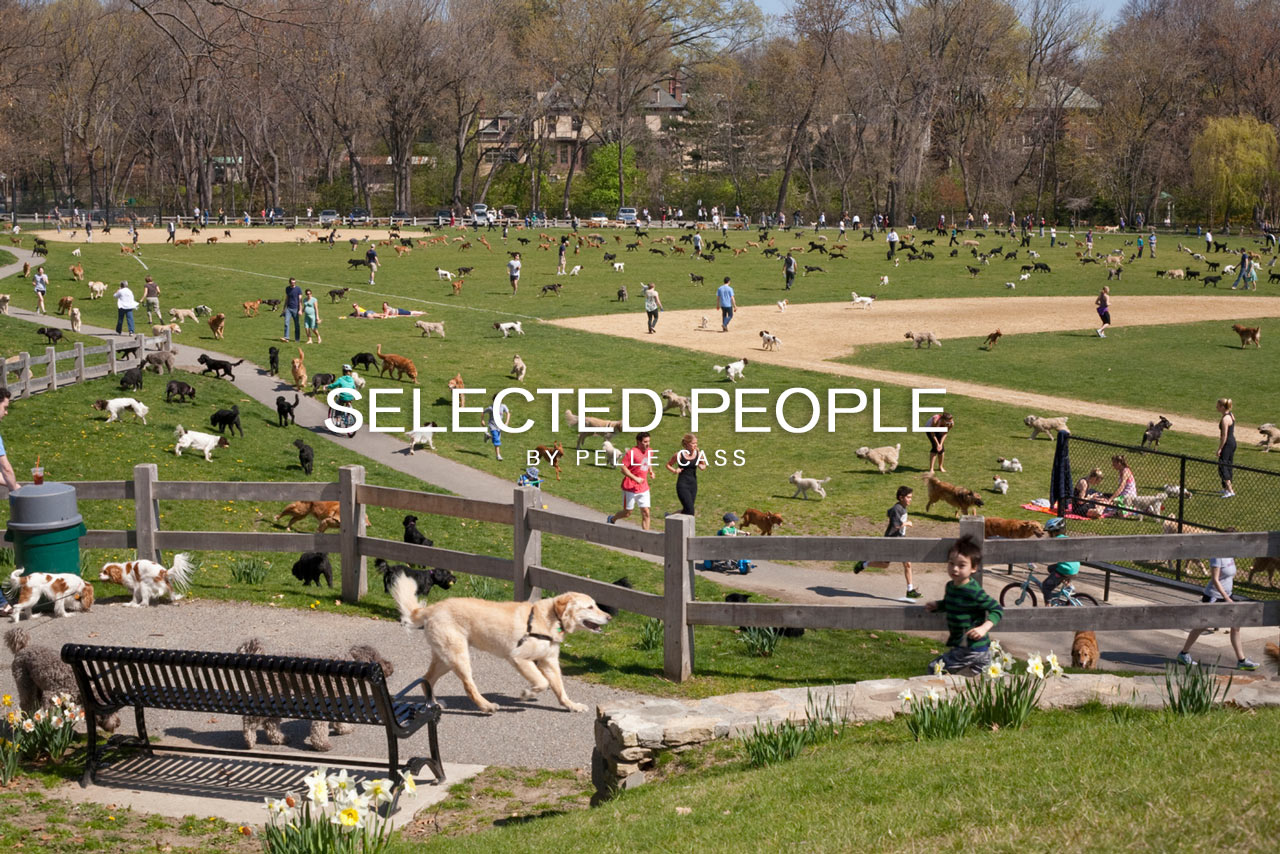
This work both orders the world and exaggerates its chaos. With the camera on a tripod, I take many photos, leave in the best ones and omit the rest. The photographs are composed but they have not been changed, only selected. My work is about the strangeness of time, about how people really look, and about the surprising world that is only visible with a camera. I want to capture more life, more people, more time, and more truth in my photographs. Photography, with its ability to record everything in front of the lens, is just the beginning of this process. Selected People is inspired by surveillance photography, Walker Evans’s hidden-camera subway portraits, and P.L. di Corcia’s Head series; works in which the camera waits for its subjects to come into view. My work also looks at city life from a fixed position, with the difference that each image contains an hour’s time and is a composition of hundreds of exposures. To do this, I put the camera on a tripod, and take hundreds of pictures as people pass by. Back in the studio, I choose what to leave in and make no further alterations. The process mirrors the way the mind focuses attention on one thing but not on another. A person thinking about photography, for example, tends to notice people with cameras over those without. This kind of selection allows me to take objective facts–the faces and bodies of people on the street–and make something new and more subjective out of them, simply by sorting them. Above all, I want to show a surprising world that is visible only with a camera.

















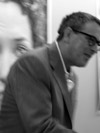 Pelle Cass (Brookline, MA). He has presented solo shows at the Houston Center for Photography; Gallery Kayafas, Boston; Stux Gallery, Boston; Frank Marino Gallery, NYC; the Griffin Museum of Photography; and the Fogg Art Museum’s print room. His work is in the collections of the Fogg Art Museum, the Addison Gallery of American Art, the Polaroid Collection, the DeCordova Museum, the Danforth Museum of Art, the Peabody Essex Museum, the Museum of Fine Arts, Houston, and the Lehigh University Art Galleries, among others. He was a Winner: Top 50, Critical Mass, Photolucida, Portland, OR, in 2008 and 2009, was awarded fellowships by the Corporation of Yaddo in 2010 and 2012, and won an Artist’s Resource Trust Award (Berkshire Taconic Foundation) in 2012. He lives in Brookline, Massachusetts.
Pelle Cass (Brookline, MA). He has presented solo shows at the Houston Center for Photography; Gallery Kayafas, Boston; Stux Gallery, Boston; Frank Marino Gallery, NYC; the Griffin Museum of Photography; and the Fogg Art Museum’s print room. His work is in the collections of the Fogg Art Museum, the Addison Gallery of American Art, the Polaroid Collection, the DeCordova Museum, the Danforth Museum of Art, the Peabody Essex Museum, the Museum of Fine Arts, Houston, and the Lehigh University Art Galleries, among others. He was a Winner: Top 50, Critical Mass, Photolucida, Portland, OR, in 2008 and 2009, was awarded fellowships by the Corporation of Yaddo in 2010 and 2012, and won an Artist’s Resource Trust Award (Berkshire Taconic Foundation) in 2012. He lives in Brookline, Massachusetts.
This work both orders the world and exaggerates its chaos. With the camera on a tripod, I take many photos, leave in the best ones and omit the rest. The photographs are composed but they have not been changed, only selected. My work is about the strangeness of time, about how people really look, and about the surprising world that is only visible with a camera. I want to capture more life, more people, more time, and more truth in my photographs. Photography, with its ability to record everything in front of the lens, is just the beginning of this process. Selected People is inspired by surveillance photography, Walker Evans’s hidden-camera subway portraits, and P.L. di Corcia’s Head series; works in which the camera waits for its subjects to come into view. My work also looks at city life from a fixed position, with the difference that each image contains an hour’s time and is a composition of hundreds of exposures. To do this, I put the camera on a tripod, and take hundreds of pictures as people pass by. Back in the studio, I choose what to leave in and make no further alterations. The process mirrors the way the mind focuses attention on one thing but not on another. A person thinking about photography, for example, tends to notice people with cameras over those without. This kind of selection allows me to take objective facts–the faces and bodies of people on the street–and make something new and more subjective out of them, simply by sorting them. Above all, I want to show a surprising world that is visible only with a camera.

















 Pelle Cass (Brookline, MA). He has presented solo shows at the Houston Center for Photography; Gallery Kayafas, Boston; Stux Gallery, Boston; Frank Marino Gallery, NYC; the Griffin Museum of Photography; and the Fogg Art Museum’s print room. His work is in the collections of the Fogg Art Museum, the Addison Gallery of American Art, the Polaroid Collection, the DeCordova Museum, the Danforth Museum of Art, the Peabody Essex Museum, the Museum of Fine Arts, Houston, and the Lehigh University Art Galleries, among others. He was a Winner: Top 50, Critical Mass, Photolucida, Portland, OR, in 2008 and 2009, was awarded fellowships by the Corporation of Yaddo in 2010 and 2012, and won an Artist’s Resource Trust Award (Berkshire Taconic Foundation) in 2012. He lives in Brookline, Massachusetts.
Pelle Cass (Brookline, MA). He has presented solo shows at the Houston Center for Photography; Gallery Kayafas, Boston; Stux Gallery, Boston; Frank Marino Gallery, NYC; the Griffin Museum of Photography; and the Fogg Art Museum’s print room. His work is in the collections of the Fogg Art Museum, the Addison Gallery of American Art, the Polaroid Collection, the DeCordova Museum, the Danforth Museum of Art, the Peabody Essex Museum, the Museum of Fine Arts, Houston, and the Lehigh University Art Galleries, among others. He was a Winner: Top 50, Critical Mass, Photolucida, Portland, OR, in 2008 and 2009, was awarded fellowships by the Corporation of Yaddo in 2010 and 2012, and won an Artist’s Resource Trust Award (Berkshire Taconic Foundation) in 2012. He lives in Brookline, Massachusetts.Mauricio Alejo
In relation to his videos Mauricio shared the following reflexion with us, that was part of an interview he gave:
Recently I was interviewed by Katrin Steffen. She asked me what I thought of the idea of my videos being surreal. The question caught me off guard; not that I was completely unaware of this, let’s say, approach to my work - other people have made the same observation - but it was the direct, straightforward way in which she formulated her question that struck me.
It is interesting that, until then, I had been resisting calling my work surreal. I don’t know why. I just unreflectively didn't like the idea, but once the question was out I had no option but to come to terms with what I was so stubbornly denying.
Answering it was both liberating and enlightening. I came to understand that, indeed, there is a strong surreal element to my work, probably “á la Magritte” as in “This is not a Pipe” (as opposed to “á la Dalí”, whose work I dislike; it is too spectacular for my taste).
Either way, what I can say is that I’m not trying to open a door to the unconscious, but to a more obvious and factual world that is still surprising, because it actually exists and is just hidden in plain sight.
These lines show a desire to offer a new way of looking at a universe that is hidden behind the false transparency of the photographic language.
In several of the works presented here, our reading of a still image is transformed—thanks to the passage of time—into something completely different. The surprising elements in the universe are infinitely more casual. Gravity, in an unforeseen twist, belies the lightness of the air.
In all of them, the passage of time is a necessary element to show that photography can be a map of the reality but is not equal to it, like for example in the piece World: the world that not stops to move is different from the world that not stops to move around it, and in turn different from our world that also does not slow down.
| Universe |
Line |
Hole |
| Gravity |
Twig |
Crack |
| Container |
Fact and fiction |
World |
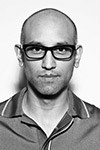 Mauricio Alejo (Mexico, 1969). He earned his Master of Art from New York University in 2002, as a Fulbright Grant recipient. In 2007, he was a resident artist at NUS Centre for the Arts in Singapore. He has received multiple awards and grants, including the New York Foundation for the Arts grant in 2008. His work is part of important collections such as Daros Latinoamérica Collection in Zürich . His work has been reviewed in important journals, such as Flash Art; Art News and Art in America. He has had solo exhibitions in New York, Japan, Madrid, Paris and Mexico. His work has been shown at CCA Wattis Institute of Contemporary Arts in San Francisco; Museo Centro de Arte Reina Sofía in Madrid and The 8th Havana Biennial among other venues. He currently lives and works in New York City.
Mauricio Alejo (Mexico, 1969). He earned his Master of Art from New York University in 2002, as a Fulbright Grant recipient. In 2007, he was a resident artist at NUS Centre for the Arts in Singapore. He has received multiple awards and grants, including the New York Foundation for the Arts grant in 2008. His work is part of important collections such as Daros Latinoamérica Collection in Zürich . His work has been reviewed in important journals, such as Flash Art; Art News and Art in America. He has had solo exhibitions in New York, Japan, Madrid, Paris and Mexico. His work has been shown at CCA Wattis Institute of Contemporary Arts in San Francisco; Museo Centro de Arte Reina Sofía in Madrid and The 8th Havana Biennial among other venues. He currently lives and works in New York City.In relation to his videos Mauricio shared the following reflexion with us, that was part of an interview he gave:
Recently I was interviewed by Katrin Steffen. She asked me what I thought of the idea of my videos being surreal. The question caught me off guard; not that I was completely unaware of this, let’s say, approach to my work - other people have made the same observation - but it was the direct, straightforward way in which she formulated her question that struck me.
It is interesting that, until then, I had been resisting calling my work surreal. I don’t know why. I just unreflectively didn't like the idea, but once the question was out I had no option but to come to terms with what I was so stubbornly denying.
Answering it was both liberating and enlightening. I came to understand that, indeed, there is a strong surreal element to my work, probably “á la Magritte” as in “This is not a Pipe” (as opposed to “á la Dalí”, whose work I dislike; it is too spectacular for my taste).
Either way, what I can say is that I’m not trying to open a door to the unconscious, but to a more obvious and factual world that is still surprising, because it actually exists and is just hidden in plain sight.
These lines show a desire to offer a new way of looking at a universe that is hidden behind the false transparency of the photographic language.
In several of the works presented here, our reading of a still image is transformed—thanks to the passage of time—into something completely different. The surprising elements in the universe are infinitely more casual. Gravity, in an unforeseen twist, belies the lightness of the air.
In all of them, the passage of time is a necessary element to show that photography can be a map of the reality but is not equal to it, like for example in the piece World: the world that not stops to move is different from the world that not stops to move around it, and in turn different from our world that also does not slow down.
| Universe |
Line |
Hole |
| Gravity |
Twig |
Crack |
| Container |
Fact and fiction |
World |
 Mauricio Alejo (Mexico, 1969). He earned his Master of Art from New York University in 2002, as a Fulbright Grant recipient. In 2007, he was a resident artist at NUS Centre for the Arts in Singapore. He has received multiple awards and grants, including the New York Foundation for the Arts grant in 2008. His work is part of important collections such as Daros Latinoamérica Collection in Zürich . His work has been reviewed in important journals, such as Flash Art; Art News and Art in America. He has had solo exhibitions in New York, Japan, Madrid, Paris and Mexico. His work has been shown at CCA Wattis Institute of Contemporary Arts in San Francisco; Museo Centro de Arte Reina Sofía in Madrid and The 8th Havana Biennial among other venues. He currently lives and works in New York City.
Mauricio Alejo (Mexico, 1969). He earned his Master of Art from New York University in 2002, as a Fulbright Grant recipient. In 2007, he was a resident artist at NUS Centre for the Arts in Singapore. He has received multiple awards and grants, including the New York Foundation for the Arts grant in 2008. His work is part of important collections such as Daros Latinoamérica Collection in Zürich . His work has been reviewed in important journals, such as Flash Art; Art News and Art in America. He has had solo exhibitions in New York, Japan, Madrid, Paris and Mexico. His work has been shown at CCA Wattis Institute of Contemporary Arts in San Francisco; Museo Centro de Arte Reina Sofía in Madrid and The 8th Havana Biennial among other venues. He currently lives and works in New York City.Felipe Mejías López

Penitents of the brotherhood of Sorrows, posing with the image of the Virgin during the Easter Week in Aspe (Spain).
March 1929. (Photographer unknown. About photograhy Felipe Mejías, March 2015).
Paper memories. Photographs will always be paper memories, despite the fact that the emergence of digital technology in the world of images has changed the way they are stored. In any case, whether they are stuck in an album, crammed into an old biscuit tin, or stored in a virtual folder tucked away in the darkest corner of our computer’s hard drive, the construction of our memories owes a great deal to these images in black and white or faded colors. We can often reconstruct the exact layout of a place we have been, or feel the gaze of a friend or family member we no longer see because we can re-encounter them when we contemplate these square cardboard remnants. Memory cards and smart phones belong to a different visual universe that has no history but is a slave to the future, subject to a dictatorship that imposes the objective of immediacy and the compulsive desire to devour the overwhelming reality that surrounds us as if it might suddenly and permanently disappear from one moment to the next.
Photographs take us back to what we once were, in a constant, palpable, evident graphic salvation that is fed by our gaze like a fossil into which we breathe life simply by contemplating it. Looking at photos makes us grow, whether or not we want to, because we end up recognizing ourselves in them, somehow transformed into strangers we find it increasingly difficult to recognize: yet, there we are, participating like enthusiastic actors or perhaps behind the viewfinder snapping a photo. This tangible, visual certainty, together with the awareness that time has passed because we remember, creates an incredibly strong sensory cement that binds and gives meaning to our life stories.
But if we broaden the focus and think about our innumerable private –and therefore secret– photographs as a whole that have been collected since the beginning of photography, scattered throughout our immediate environment (not only in our family or neighborhood, but also throughout the macro scale of the city or region where we live), then these images evolve from more than a repertoire of personal memories to cultural objects. And as such, because of the historical, anthropological and ethnological information they contain, these photographs become unique, inimitable objects that deserve to be compiled, studied and published, in the same way we would share material found at an archeological dig or written documents from an historical archive.
Finally, those of us who work with this type of image consider it an act of social justice to return them to the community that produced them, that truly owns them. However, we return something that has been enriched by the hierarchy newly acquired through the transformation of these images into an object of knowledge and study, a sort of cultural heritage, so to speak. Thus these images become the graphic and sentimental memory of a collective whose cohesion is reinforced by their existence.
Initiatives of this type exist everywhere, although they do not always manage to develop the full potential stored within old photographs. The formation of multidisciplinary work teams that include historians and ethnographers familiar with local intra-history could be the key to successfully publishing work that would otherwise be converted into mere catalogs of orphaned images, macabre galleries exhibiting, as if embalmed, anonymous, unknown, dead people. Mere fetishes.
A small example of a local publication using old photographs as axial argument, which we think has achieved satisfactory results, is the project titled Recovered Memories. Photography and Society in Aspe 1870-1976. Field work begun in 1996 and still ongoing, has discovered and documented almost 4,000 images that have been recovered and selected from the private photographic repertoire generated by a small, southeastern Spanish urban community for over a century. The photographs have been classified into 24 different thematic categories that do not lost sight of the transversality of the contents that emerge from the photographs, which are teeming with sociological, anthropological and historical information.

Nazarenes, carrying the cross on their shoulders during the morning procession on Good Friday in Aspe (Spain).
(Photographer unknown, around 1955/Felipe Mejías, March 2015).
From an historian or archeologist’s point of view, it would have been unforgiveable not to try to find new ways to learn about the past with such valuable resources at hand. This is the point where rephotography begins.
It comes as no surprise to find that there are already masters of this relatively young discipline. However, there are only two things you can do with the work of Mark Klett and Camilo José Vergara watch and learn. Sergey Larenkov, Ricard Martínez, Hebe Robinson, Irina Werning, Gustavo Germano and Douglas Levere also produce work that comes very close to visual poetry. Many of them also enter the realm of social and political denunciation, making it quite clear that rephotography is not only a form of technical and aesthetic entertainment, but also a tool that helps us stop and reflect on the collateral damage associated with the passage of time.
But why rephotography? For someone who constantly thinks about the consequences and meaning of the passage of time, it is particularly gratifying to intervene in the process of creating an unattainable fiction through photography: blending the past and the present into a unique instant, taking on the role of a mischievous god in the age-old quest for immortality. Cernuda used to say: “[...] times are identical / gazes are different [...],” and something of this inspiration lurks beneath the ultimate goal of rephotography, attempting to stop and mix time, perceiving it without its having passed, or rather, perceiving if as if it had not done so. Making time manageable, cyclical and malleable is an heroic, almost obsessive exercise that goes beyond the purely visual mannerist trompe-l’oeil to reveal a little of the artifice behind the deception. The point is to photograph what other eyes before ours saw, in the same place, in the same instant, using the same technique. It is as if we brought the original photographer back to life and had him beside us, whispering the correct focus into our ear. Furthermore, if we do it in the place where we were born and raised, we can sublimate the nostalgic component each rephotograph inevitably contains: being right now where someone was long before us and seeing, touching and smelling the same environment. Feeling the same as that person. Being that person.
Overlapping, contrasting, recreating through transparencies and seeing how the different layers of memory deposited over the years, flourish and contribute to the task of creating the illusion that the old and new images are actually different sides of the same reality. A new discourse about the obvious contrast between the past and present, what is and what is not, is created, runs the risk of getting stuck at the anecdotal level. Even so, it may be enough. Although it is possible to try something else: building an imaginary cage in which to enclose two similar instances separated by time in the hope that they can live together and perhaps end up becoming a single moment. Just like in the Frankenstein myth, we give birth to impossible, two-headed monsters, Siamese twins that must always share different moments of the same existence. We give them a voice, and the possibility of shouting and discovering what is hidden within; their wrinkles, how the space or person has aged; what remains of what they once were. The experiment is not always successful, but it sometimes works and eventually creates a new scene where everything fits together marvelously; shapes continue and intertwine without signaling eras; grays and colors merge into a single light. It is a small miracle fixed in a subtle, crystalline, almost imperceptible balance.
But let us not deceive ourselves. In reality everything is always the past. The unattainable past. We like to think that rephotography gives us the possibility of returning to the past, to rethink it and try to bring it back to life. Poor fools, as if we could bring it back to a time and place it actually never left.
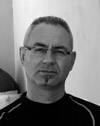 Felipe Mejías López (Spain, 1968). Lives and works in Spain. Historian and archaeologist. BA in Geography and History with a major in Art History from the University of Valencia. MA in Professional Archaeology and Heritage Management from the University of Alicante. A lot of his publications revolve around the archaeological, historical, artistic, documentary and photographic heritage of his native town, Aspe. Currently, he is editing the third volume of his research project on ancient photography and social history Recovered Memories. For this project, he studied the field of rephotography.
Felipe Mejías López (Spain, 1968). Lives and works in Spain. Historian and archaeologist. BA in Geography and History with a major in Art History from the University of Valencia. MA in Professional Archaeology and Heritage Management from the University of Alicante. A lot of his publications revolve around the archaeological, historical, artistic, documentary and photographic heritage of his native town, Aspe. Currently, he is editing the third volume of his research project on ancient photography and social history Recovered Memories. For this project, he studied the field of rephotography.
Penitents of the brotherhood of Sorrows, posing with the image of the Virgin during the Easter Week in Aspe (Spain).
March 1929. (Photographer unknown. About photograhy Felipe Mejías, March 2015).
Paper memories. Photographs will always be paper memories, despite the fact that the emergence of digital technology in the world of images has changed the way they are stored. In any case, whether they are stuck in an album, crammed into an old biscuit tin, or stored in a virtual folder tucked away in the darkest corner of our computer’s hard drive, the construction of our memories owes a great deal to these images in black and white or faded colors. We can often reconstruct the exact layout of a place we have been, or feel the gaze of a friend or family member we no longer see because we can re-encounter them when we contemplate these square cardboard remnants. Memory cards and smart phones belong to a different visual universe that has no history but is a slave to the future, subject to a dictatorship that imposes the objective of immediacy and the compulsive desire to devour the overwhelming reality that surrounds us as if it might suddenly and permanently disappear from one moment to the next.
Photographs take us back to what we once were, in a constant, palpable, evident graphic salvation that is fed by our gaze like a fossil into which we breathe life simply by contemplating it. Looking at photos makes us grow, whether or not we want to, because we end up recognizing ourselves in them, somehow transformed into strangers we find it increasingly difficult to recognize: yet, there we are, participating like enthusiastic actors or perhaps behind the viewfinder snapping a photo. This tangible, visual certainty, together with the awareness that time has passed because we remember, creates an incredibly strong sensory cement that binds and gives meaning to our life stories.
But if we broaden the focus and think about our innumerable private –and therefore secret– photographs as a whole that have been collected since the beginning of photography, scattered throughout our immediate environment (not only in our family or neighborhood, but also throughout the macro scale of the city or region where we live), then these images evolve from more than a repertoire of personal memories to cultural objects. And as such, because of the historical, anthropological and ethnological information they contain, these photographs become unique, inimitable objects that deserve to be compiled, studied and published, in the same way we would share material found at an archeological dig or written documents from an historical archive.
Finally, those of us who work with this type of image consider it an act of social justice to return them to the community that produced them, that truly owns them. However, we return something that has been enriched by the hierarchy newly acquired through the transformation of these images into an object of knowledge and study, a sort of cultural heritage, so to speak. Thus these images become the graphic and sentimental memory of a collective whose cohesion is reinforced by their existence.
Initiatives of this type exist everywhere, although they do not always manage to develop the full potential stored within old photographs. The formation of multidisciplinary work teams that include historians and ethnographers familiar with local intra-history could be the key to successfully publishing work that would otherwise be converted into mere catalogs of orphaned images, macabre galleries exhibiting, as if embalmed, anonymous, unknown, dead people. Mere fetishes.
A small example of a local publication using old photographs as axial argument, which we think has achieved satisfactory results, is the project titled Recovered Memories. Photography and Society in Aspe 1870-1976. Field work begun in 1996 and still ongoing, has discovered and documented almost 4,000 images that have been recovered and selected from the private photographic repertoire generated by a small, southeastern Spanish urban community for over a century. The photographs have been classified into 24 different thematic categories that do not lost sight of the transversality of the contents that emerge from the photographs, which are teeming with sociological, anthropological and historical information.

Nazarenes, carrying the cross on their shoulders during the morning procession on Good Friday in Aspe (Spain).
(Photographer unknown, around 1955/Felipe Mejías, March 2015).
From an historian or archeologist’s point of view, it would have been unforgiveable not to try to find new ways to learn about the past with such valuable resources at hand. This is the point where rephotography begins.
It comes as no surprise to find that there are already masters of this relatively young discipline. However, there are only two things you can do with the work of Mark Klett and Camilo José Vergara watch and learn. Sergey Larenkov, Ricard Martínez, Hebe Robinson, Irina Werning, Gustavo Germano and Douglas Levere also produce work that comes very close to visual poetry. Many of them also enter the realm of social and political denunciation, making it quite clear that rephotography is not only a form of technical and aesthetic entertainment, but also a tool that helps us stop and reflect on the collateral damage associated with the passage of time.
But why rephotography? For someone who constantly thinks about the consequences and meaning of the passage of time, it is particularly gratifying to intervene in the process of creating an unattainable fiction through photography: blending the past and the present into a unique instant, taking on the role of a mischievous god in the age-old quest for immortality. Cernuda used to say: “[...] times are identical / gazes are different [...],” and something of this inspiration lurks beneath the ultimate goal of rephotography, attempting to stop and mix time, perceiving it without its having passed, or rather, perceiving if as if it had not done so. Making time manageable, cyclical and malleable is an heroic, almost obsessive exercise that goes beyond the purely visual mannerist trompe-l’oeil to reveal a little of the artifice behind the deception. The point is to photograph what other eyes before ours saw, in the same place, in the same instant, using the same technique. It is as if we brought the original photographer back to life and had him beside us, whispering the correct focus into our ear. Furthermore, if we do it in the place where we were born and raised, we can sublimate the nostalgic component each rephotograph inevitably contains: being right now where someone was long before us and seeing, touching and smelling the same environment. Feeling the same as that person. Being that person.
Overlapping, contrasting, recreating through transparencies and seeing how the different layers of memory deposited over the years, flourish and contribute to the task of creating the illusion that the old and new images are actually different sides of the same reality. A new discourse about the obvious contrast between the past and present, what is and what is not, is created, runs the risk of getting stuck at the anecdotal level. Even so, it may be enough. Although it is possible to try something else: building an imaginary cage in which to enclose two similar instances separated by time in the hope that they can live together and perhaps end up becoming a single moment. Just like in the Frankenstein myth, we give birth to impossible, two-headed monsters, Siamese twins that must always share different moments of the same existence. We give them a voice, and the possibility of shouting and discovering what is hidden within; their wrinkles, how the space or person has aged; what remains of what they once were. The experiment is not always successful, but it sometimes works and eventually creates a new scene where everything fits together marvelously; shapes continue and intertwine without signaling eras; grays and colors merge into a single light. It is a small miracle fixed in a subtle, crystalline, almost imperceptible balance.
But let us not deceive ourselves. In reality everything is always the past. The unattainable past. We like to think that rephotography gives us the possibility of returning to the past, to rethink it and try to bring it back to life. Poor fools, as if we could bring it back to a time and place it actually never left.
 Felipe Mejías López (Spain, 1968). Lives and works in Spain. Historian and archaeologist. BA in Geography and History with a major in Art History from the University of Valencia. MA in Professional Archaeology and Heritage Management from the University of Alicante. A lot of his publications revolve around the archaeological, historical, artistic, documentary and photographic heritage of his native town, Aspe. Currently, he is editing the third volume of his research project on ancient photography and social history Recovered Memories. For this project, he studied the field of rephotography.
Felipe Mejías López (Spain, 1968). Lives and works in Spain. Historian and archaeologist. BA in Geography and History with a major in Art History from the University of Valencia. MA in Professional Archaeology and Heritage Management from the University of Alicante. A lot of his publications revolve around the archaeological, historical, artistic, documentary and photographic heritage of his native town, Aspe. Currently, he is editing the third volume of his research project on ancient photography and social history Recovered Memories. For this project, he studied the field of rephotography.Gabriel de la Mora

This series of altered photographs comes from a set of negatives that was destroyed when the warehouse where they had been stored for decades was flooded. This is why some of the negatives were stuck together, some of them showing two different takes of the same person and others two or three different people. They are negatives of portraits taken in 1948 and 1949 by Víctor Villamil Vilón at Cano Photography Studios, later called Vilón Photography Studios in Bogotá, Colombia. The images were printed on silver gel with fibrous paper in Mexico City and subsequently altered and framed. The artist begins his work by tearing off pieces of the photo.
Time and light do the rest, erasing the photographic image completely and leaving a monochrome surface. Only then is the work finished. Therefore 50, 100 or 300 years will have to pass, depending on the conditions in which the work is found. The artist never completes the piece and will surely never see it finished. This series is a parallel to the altered space entitled Pan-American Exhibition at NC ARTE.

























 Gabriel de la Mora (Mexico 1968). Studied a masters in painting, photography and video at the Pratt Institute in New York (2001-2003) and a bachelors in architecture at the Universidad Anáhuac del Norte (1987-1991) in Mexico City. He is currently a member of the Sistema Nacional de Creadores de Arte (2013-2015) and has received a number of awards and grants including the Primer Premio de la VII Bienal de Monterrey FEMSA, the Garcia Robles Fulbright Grant and the Jacques and Natasha Gelman Grant among others. His work as been shown in Mexico and abroad both individually and collectively.
Gabriel de la Mora (Mexico 1968). Studied a masters in painting, photography and video at the Pratt Institute in New York (2001-2003) and a bachelors in architecture at the Universidad Anáhuac del Norte (1987-1991) in Mexico City. He is currently a member of the Sistema Nacional de Creadores de Arte (2013-2015) and has received a number of awards and grants including the Primer Premio de la VII Bienal de Monterrey FEMSA, the Garcia Robles Fulbright Grant and the Jacques and Natasha Gelman Grant among others. His work as been shown in Mexico and abroad both individually and collectively.ZZ. In the project called Archive V.V. 1948 -49 how do you establish the photograph/time relationship? How does it affect the image both as an external and intrinsic element?
GM. Photographic technique is a constantly changing process. Depending upon the passage of time and light, on how the photo has been exposed to these two factors, it can slowly fade and begin to disappear. Which initially worried me for this project. But I think that later this inevitable factor became a starting point for various series in which I used photography as primary or supporting material.
In most of my work, photography is an important element, whether as a file or a document, or a starting point as it was for Willy Kautz in his work shown at the Amparo Museum from October 2014 to February 2015 under the title "What watches us that we don’t see.” The starting point in this exhibit was how an image becomes monochromatic and how a monochrome can become an image.
Although I take photographs to document pieces and processes, amongst many other things, I like to work with vintage photographs from the late 19th to the late 20th century. I buy archives, classify them and then begin my explorations. For the Archive V.V. 1948-49 project I used destroyed negatives for the first time. The alterations were both accidental and due to the passage of time, which produced astounding results.
The Vilón Archive series began in 2012 while I was preparing for my first altered space project at the NC ARTE gallery in Bogotá Colombia. As an alternative activity to the show called Pan-American Exhibition curated by Willy Kautz, I visited an old photography studio near the NC ARTE gallery. I was hoping to find vintage portraits taken in Bogotá in 1948-1949.
Victor Vilón’s children, Germán and Patricia Vilón, who owned the Vilón Photography Studio, told me that although they had no old photographs they did have some negatives which they would look for to show me. Two days later I turned up punctually for our appointment and both Patricia and Germán had a look of utter frustration: they showed me a cardboard box containing hundreds of negatives that had been destroyed by a flood in the warehouse where they had been stored, which no-one had noticed. Patricia showed me various negatives that were stuck together and would break when separated and told me they were going to throw it all away. When I saw some of the negatives, I found them far more interesting than they would have been if they had not got wet. So I asked Germán if they could print the negatives in their destroyed state and he told me that they could, but that they would turn out badly. I chose a few and asked for examples. A couple of days later, these examples exceeded my expectations. Previously, I would buy vintage photographs from Mexican movies and alter them by randomly tearing part of the film to transform the narrative and configuration through a process of abstraction and destruction.
Before destroying each image I would scan both sides so that each altered photograph could be added to my digital archives.
The destroyed negatives from Archive V.V. had not been altered by me, but by an accident that destroyed them over time, so the artistic process for series like the one on Mexican movies was carried out by time rather than by me. The result is simply amazing. To rescue the negatives from the garbage I asked German and Patricia to sell them to me to keep in Mexico where I could continue experimenting with the series of images.
ZZ. How much do you intervene in the construction of a photographic image and at what point is it beyond your control?
GM. As an artist I like to have control over certain pieces or series, but I also like to lose absolute control over other series in particular, or occasionally combine both: control and randomness.
With regards to the destroyed negatives, or Archive V.V. 1948-49, the majority of alterations were made by the flood and time and the results were the starting point for a new series. When printed, the images were extraordinary, unique, and I did not intervene in them at all except for finding and recovering them. It was like a type of assisted Ready Made, as Francisco Reyes Palma so aptly called it. Once the photos had been printed, I altered them again by tearing part of the photographic film off and leaving the fragments at the bottom of the frame. This begins a process that, depending on the conditions in which the photo is stored, time and light, will cause the image to entirely disappear in maybe 50, 100 or more years, transforming the photo into a monochrome white surface. When this finally happens, the piece will be completed. “The artist only begins the piece, but will never see it finished as its process continues over time even after the artist’s death.”
Back in Mexico, I went to a photography laboratory to print the negatives I had chosen on fiber paper in a similar way. Once they were printed, but before framing them, I altered them randomly, tearing bits of photographic film off and saving them so that after the photo had been framed, they would be at the bottom of the frame.
What most interests me is what happens after the first intervention when the destroyed negative is printed. I intervene again by tearing off small pieces of the image, thereby beginning my piece of work, since time, light and varied storage conditions will complete the piece.
ZZ. When the object mediates between the artist and the spectator, what type of reflection does it incite?
GM. At the end of the day, everything vanishes. Nothing is eternal and everything is subject to constant change and transformation. Art is neither created nor destroyed, only transformed.
In my work, I like to introduce the works. They do everything. There is a an interesting visual, formal and technical factor that makes an initial, perhaps more emotional impact. Afterwards, you can explore what goes on behind the process, and the work itself has various levels of information where one question leads to another, and so on, indefinitely.
When something attracts your attention and you like it but it also makes you think, for me, that is the point where the work becomes whole. Each person will have a different opinion or reaction depending on the level and type of previous information they possess. The images or works in this series, for example, have received differing opinions and reflections. In some people they elicit nostalgia for an era, a person who no longer exists or who died years ago; for others, it produces a certain mystery, or even fear, since some of the faces or images are rather ghostlike.
Personally, I believe that the images are powerful in every respect. They have an extraordinary composition and were, in a way, part of an archive which, when it was destroyed, fulfilled its destiny by becoming waste. This is a footnote for me as an artist, knowing that what comes at the end of one thing can be the beginning of another. This waste or residual material can be transformed into artwork.
When two or more negatives in the archive are stuck together and then break and are fragmented into other images, the way I print them turns them into something extraordinary. They have been altered by time, through a naturally destructive process, making the image into an abstraction with a strange composition. The people still exist in them, or their presence is registered, together with a whole era. Thus the images are historic documents that are transformed into something else.
The original author of these portraits was Don Victor Villamil Vilón, and now I am the author. I love to find new ways of experimenting with photography. I did not originally take these photographs, but I did rescue them from the becoming garbage after they had been destroyed in a flood and now they are prime examples for exploring image through records, archives and documents.

This series of altered photographs comes from a set of negatives that was destroyed when the warehouse where they had been stored for decades was flooded. This is why some of the negatives were stuck together, some of them showing two different takes of the same person and others two or three different people. They are negatives of portraits taken in 1948 and 1949 by Víctor Villamil Vilón at Cano Photography Studios, later called Vilón Photography Studios in Bogotá, Colombia. The images were printed on silver gel with fibrous paper in Mexico City and subsequently altered and framed. The artist begins his work by tearing off pieces of the photo.
Time and light do the rest, erasing the photographic image completely and leaving a monochrome surface. Only then is the work finished. Therefore 50, 100 or 300 years will have to pass, depending on the conditions in which the work is found. The artist never completes the piece and will surely never see it finished. This series is a parallel to the altered space entitled Pan-American Exhibition at NC ARTE.

























 Gabriel de la Mora (Mexico 1968). Studied a masters in painting, photography and video at the Pratt Institute in New York (2001-2003) and a bachelors in architecture at the Universidad Anáhuac del Norte (1987-1991) in Mexico City. He is currently a member of the Sistema Nacional de Creadores de Arte (2013-2015) and has received a number of awards and grants including the Primer Premio de la VII Bienal de Monterrey FEMSA, the Garcia Robles Fulbright Grant and the Jacques and Natasha Gelman Grant among others. His work as been shown in Mexico and abroad both individually and collectively.
Gabriel de la Mora (Mexico 1968). Studied a masters in painting, photography and video at the Pratt Institute in New York (2001-2003) and a bachelors in architecture at the Universidad Anáhuac del Norte (1987-1991) in Mexico City. He is currently a member of the Sistema Nacional de Creadores de Arte (2013-2015) and has received a number of awards and grants including the Primer Premio de la VII Bienal de Monterrey FEMSA, the Garcia Robles Fulbright Grant and the Jacques and Natasha Gelman Grant among others. His work as been shown in Mexico and abroad both individually and collectively.ZZ. In the project called Archive V.V. 1948 -49 how do you establish the photograph/time relationship? How does it affect the image both as an external and intrinsic element?
GM. Photographic technique is a constantly changing process. Depending upon the passage of time and light, on how the photo has been exposed to these two factors, it can slowly fade and begin to disappear. Which initially worried me for this project. But I think that later this inevitable factor became a starting point for various series in which I used photography as primary or supporting material.
In most of my work, photography is an important element, whether as a file or a document, or a starting point as it was for Willy Kautz in his work shown at the Amparo Museum from October 2014 to February 2015 under the title "What watches us that we don’t see.” The starting point in this exhibit was how an image becomes monochromatic and how a monochrome can become an image.
Although I take photographs to document pieces and processes, amongst many other things, I like to work with vintage photographs from the late 19th to the late 20th century. I buy archives, classify them and then begin my explorations. For the Archive V.V. 1948-49 project I used destroyed negatives for the first time. The alterations were both accidental and due to the passage of time, which produced astounding results.
The Vilón Archive series began in 2012 while I was preparing for my first altered space project at the NC ARTE gallery in Bogotá Colombia. As an alternative activity to the show called Pan-American Exhibition curated by Willy Kautz, I visited an old photography studio near the NC ARTE gallery. I was hoping to find vintage portraits taken in Bogotá in 1948-1949.
Victor Vilón’s children, Germán and Patricia Vilón, who owned the Vilón Photography Studio, told me that although they had no old photographs they did have some negatives which they would look for to show me. Two days later I turned up punctually for our appointment and both Patricia and Germán had a look of utter frustration: they showed me a cardboard box containing hundreds of negatives that had been destroyed by a flood in the warehouse where they had been stored, which no-one had noticed. Patricia showed me various negatives that were stuck together and would break when separated and told me they were going to throw it all away. When I saw some of the negatives, I found them far more interesting than they would have been if they had not got wet. So I asked Germán if they could print the negatives in their destroyed state and he told me that they could, but that they would turn out badly. I chose a few and asked for examples. A couple of days later, these examples exceeded my expectations. Previously, I would buy vintage photographs from Mexican movies and alter them by randomly tearing part of the film to transform the narrative and configuration through a process of abstraction and destruction.
Before destroying each image I would scan both sides so that each altered photograph could be added to my digital archives.
The destroyed negatives from Archive V.V. had not been altered by me, but by an accident that destroyed them over time, so the artistic process for series like the one on Mexican movies was carried out by time rather than by me. The result is simply amazing. To rescue the negatives from the garbage I asked German and Patricia to sell them to me to keep in Mexico where I could continue experimenting with the series of images.
ZZ. How much do you intervene in the construction of a photographic image and at what point is it beyond your control?
GM. As an artist I like to have control over certain pieces or series, but I also like to lose absolute control over other series in particular, or occasionally combine both: control and randomness.
With regards to the destroyed negatives, or Archive V.V. 1948-49, the majority of alterations were made by the flood and time and the results were the starting point for a new series. When printed, the images were extraordinary, unique, and I did not intervene in them at all except for finding and recovering them. It was like a type of assisted Ready Made, as Francisco Reyes Palma so aptly called it. Once the photos had been printed, I altered them again by tearing part of the photographic film off and leaving the fragments at the bottom of the frame. This begins a process that, depending on the conditions in which the photo is stored, time and light, will cause the image to entirely disappear in maybe 50, 100 or more years, transforming the photo into a monochrome white surface. When this finally happens, the piece will be completed. “The artist only begins the piece, but will never see it finished as its process continues over time even after the artist’s death.”
Back in Mexico, I went to a photography laboratory to print the negatives I had chosen on fiber paper in a similar way. Once they were printed, but before framing them, I altered them randomly, tearing bits of photographic film off and saving them so that after the photo had been framed, they would be at the bottom of the frame.
What most interests me is what happens after the first intervention when the destroyed negative is printed. I intervene again by tearing off small pieces of the image, thereby beginning my piece of work, since time, light and varied storage conditions will complete the piece.
ZZ. When the object mediates between the artist and the spectator, what type of reflection does it incite?
GM. At the end of the day, everything vanishes. Nothing is eternal and everything is subject to constant change and transformation. Art is neither created nor destroyed, only transformed.
In my work, I like to introduce the works. They do everything. There is a an interesting visual, formal and technical factor that makes an initial, perhaps more emotional impact. Afterwards, you can explore what goes on behind the process, and the work itself has various levels of information where one question leads to another, and so on, indefinitely.
When something attracts your attention and you like it but it also makes you think, for me, that is the point where the work becomes whole. Each person will have a different opinion or reaction depending on the level and type of previous information they possess. The images or works in this series, for example, have received differing opinions and reflections. In some people they elicit nostalgia for an era, a person who no longer exists or who died years ago; for others, it produces a certain mystery, or even fear, since some of the faces or images are rather ghostlike.
Personally, I believe that the images are powerful in every respect. They have an extraordinary composition and were, in a way, part of an archive which, when it was destroyed, fulfilled its destiny by becoming waste. This is a footnote for me as an artist, knowing that what comes at the end of one thing can be the beginning of another. This waste or residual material can be transformed into artwork.
When two or more negatives in the archive are stuck together and then break and are fragmented into other images, the way I print them turns them into something extraordinary. They have been altered by time, through a naturally destructive process, making the image into an abstraction with a strange composition. The people still exist in them, or their presence is registered, together with a whole era. Thus the images are historic documents that are transformed into something else.
The original author of these portraits was Don Victor Villamil Vilón, and now I am the author. I love to find new ways of experimenting with photography. I did not originally take these photographs, but I did rescue them from the becoming garbage after they had been destroyed in a flood and now they are prime examples for exploring image through records, archives and documents.
Andrea Dorliguzzo

In 2013, Andrea Dorliguzzo started with his rephotography project Roma Ieri Oggi (Rome Yesterday Today). Driven by his passion for photography and his admiration for Rome, he started to collect old photographs of the city and combined these with contemporary ones, taken at exactly the same spot. In this way, the past and the present are brought together, causing a thrilling historical sensation which reminds us of all the great stories that the city has to tell.




















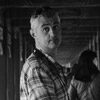 Andrea Dorliguzzo (Italy) was born in Friuli, in the north-east part of Italy. A few years ago, he moved to Rome. His passion for photography was born quite recently. Over the last years, he had the luck of traveling a lot and bringing home an unimaginable number of pictures and memories. Regarding his photos, he is very critical and only a small selection is published on his photo blog.
Andrea Dorliguzzo (Italy) was born in Friuli, in the north-east part of Italy. A few years ago, he moved to Rome. His passion for photography was born quite recently. Over the last years, he had the luck of traveling a lot and bringing home an unimaginable number of pictures and memories. Regarding his photos, he is very critical and only a small selection is published on his photo blog.
In 2013, Andrea Dorliguzzo started with his rephotography project Roma Ieri Oggi (Rome Yesterday Today). Driven by his passion for photography and his admiration for Rome, he started to collect old photographs of the city and combined these with contemporary ones, taken at exactly the same spot. In this way, the past and the present are brought together, causing a thrilling historical sensation which reminds us of all the great stories that the city has to tell.




















 Andrea Dorliguzzo (Italy) was born in Friuli, in the north-east part of Italy. A few years ago, he moved to Rome. His passion for photography was born quite recently. Over the last years, he had the luck of traveling a lot and bringing home an unimaginable number of pictures and memories. Regarding his photos, he is very critical and only a small selection is published on his photo blog.
Andrea Dorliguzzo (Italy) was born in Friuli, in the north-east part of Italy. A few years ago, he moved to Rome. His passion for photography was born quite recently. Over the last years, he had the luck of traveling a lot and bringing home an unimaginable number of pictures and memories. Regarding his photos, he is very critical and only a small selection is published on his photo blog.Eduardo Muñoz























Traveling through his memories and belongings, Eduardo Muñoz Ordoqui constructs worlds and scenarios that are situated in indefinite space-times. Cautiously merging places and occasions, he composes in his series Low Tides, Portable Worlds and Without Rest photos that involve projected images, as well as objects and their reflections. He combines the tangible and the material to create a visual journey that evokes feelings of displacement, migration and uncertainty. The images tell the story of the search for meaning among places and memories.
 Eduardo Muñoz Ordoqui (Cuba, 1964). Photographer. He received a Bachelor in Fine Arts degree in History of Art from the University of Havana in 1990 and a Master in Fine Arts in Studio Art from the University of Texas at Austin in 2005. He has taught photography for more than nine years in St. Edward’s University at Austin, Texas, where he is currently a Faculty Associate at the Department of Visual Studies. Muñoz-Ordoqui’s photographic work has been exhibited in solo and group shows in Europe, Latin America, China, and United States. He received a John Simon Guggenheim Memorial Foundation Fellowship in 1997, a Cintas Foundation Fellowship in 1998 and in 2007 was chosen for the Artpace International Artist-in-Residence program in San Antonio, Texas, USA. His photographs are held in private and institutional collections in the Americas and Europe.
Eduardo Muñoz Ordoqui (Cuba, 1964). Photographer. He received a Bachelor in Fine Arts degree in History of Art from the University of Havana in 1990 and a Master in Fine Arts in Studio Art from the University of Texas at Austin in 2005. He has taught photography for more than nine years in St. Edward’s University at Austin, Texas, where he is currently a Faculty Associate at the Department of Visual Studies. Muñoz-Ordoqui’s photographic work has been exhibited in solo and group shows in Europe, Latin America, China, and United States. He received a John Simon Guggenheim Memorial Foundation Fellowship in 1997, a Cintas Foundation Fellowship in 1998 and in 2007 was chosen for the Artpace International Artist-in-Residence program in San Antonio, Texas, USA. His photographs are held in private and institutional collections in the Americas and Europe.






















Traveling through his memories and belongings, Eduardo Muñoz Ordoqui constructs worlds and scenarios that are situated in indefinite space-times. Cautiously merging places and occasions, he composes in his series Low Tides, Portable Worlds and Without Rest photos that involve projected images, as well as objects and their reflections. He combines the tangible and the material to create a visual journey that evokes feelings of displacement, migration and uncertainty. The images tell the story of the search for meaning among places and memories.
 Eduardo Muñoz Ordoqui (Cuba, 1964). Photographer. He received a Bachelor in Fine Arts degree in History of Art from the University of Havana in 1990 and a Master in Fine Arts in Studio Art from the University of Texas at Austin in 2005. He has taught photography for more than nine years in St. Edward’s University at Austin, Texas, where he is currently a Faculty Associate at the Department of Visual Studies. Muñoz-Ordoqui’s photographic work has been exhibited in solo and group shows in Europe, Latin America, China, and United States. He received a John Simon Guggenheim Memorial Foundation Fellowship in 1997, a Cintas Foundation Fellowship in 1998 and in 2007 was chosen for the Artpace International Artist-in-Residence program in San Antonio, Texas, USA. His photographs are held in private and institutional collections in the Americas and Europe.
Eduardo Muñoz Ordoqui (Cuba, 1964). Photographer. He received a Bachelor in Fine Arts degree in History of Art from the University of Havana in 1990 and a Master in Fine Arts in Studio Art from the University of Texas at Austin in 2005. He has taught photography for more than nine years in St. Edward’s University at Austin, Texas, where he is currently a Faculty Associate at the Department of Visual Studies. Muñoz-Ordoqui’s photographic work has been exhibited in solo and group shows in Europe, Latin America, China, and United States. He received a John Simon Guggenheim Memorial Foundation Fellowship in 1997, a Cintas Foundation Fellowship in 1998 and in 2007 was chosen for the Artpace International Artist-in-Residence program in San Antonio, Texas, USA. His photographs are held in private and institutional collections in the Americas and Europe.Virgil Widrich
Copy Shop, 2001
Written, directed, produced, edited by Virgil Widrich
An original copy film. 2001, 35mm. b/w, 12 min. sound, no dialogue.
The film Copy Shop actually consist of nearly 18,000 photocopied digital frames, which are animated and filmed with a 35mm camera.
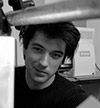 Virgil Widrich (Salzburg, 1967). Lives in Vienna. He works on numerous multimedia and film productions. His first feature film is Heller als der Mond (Brighter than the Moon). His short film Copy Shop won 35 international awards and was nominated for the Oscar. Fast Film premiered in Cannes 2003 and won 36 awards until today. At the moment Widrich is working on a new feature film The Night of a Thousand Hours.
Virgil Widrich (Salzburg, 1967). Lives in Vienna. He works on numerous multimedia and film productions. His first feature film is Heller als der Mond (Brighter than the Moon). His short film Copy Shop won 35 international awards and was nominated for the Oscar. Fast Film premiered in Cannes 2003 and won 36 awards until today. At the moment Widrich is working on a new feature film The Night of a Thousand Hours.Copy Shop, 2001
Written, directed, produced, edited by Virgil Widrich
An original copy film. 2001, 35mm. b/w, 12 min. sound, no dialogue.
The film Copy Shop actually consist of nearly 18,000 photocopied digital frames, which are animated and filmed with a 35mm camera.
 Virgil Widrich (Salzburg, 1967). Lives in Vienna. He works on numerous multimedia and film productions. His first feature film is Heller als der Mond (Brighter than the Moon). His short film Copy Shop won 35 international awards and was nominated for the Oscar. Fast Film premiered in Cannes 2003 and won 36 awards until today. At the moment Widrich is working on a new feature film The Night of a Thousand Hours.
Virgil Widrich (Salzburg, 1967). Lives in Vienna. He works on numerous multimedia and film productions. His first feature film is Heller als der Mond (Brighter than the Moon). His short film Copy Shop won 35 international awards and was nominated for the Oscar. Fast Film premiered in Cannes 2003 and won 36 awards until today. At the moment Widrich is working on a new feature film The Night of a Thousand Hours.Mónica Sánchez Escuer
Time is creation, argued Henri Bergson: “The more we explore the nature of time, the more we will understand how duration means invention, creation of forms and continuous production of the absolutely new.” (2007, p. 30).
Only insofar as time is perceived and received does it exist and acquire meaning for man. Photography and literature are two artistic media through which humanity has recreated duration and development. Both disciplines encapsulate instants: literature, a sequence of them, and photography a single instant that reveals or implies a before and an after. They capture time to show a legible fragment of its movement. Regardless of whether what they depict and relate is real or fiction, a text or a photograph bears the traces of the passage of time.
The two languages represent this passage through various forms and processes, based on the position, movement and speed of the observer-narrator, which can broadly be summarized in three moments: 1] stopped time: a literary vignette or frozen image of a scene in which the objects and/or characters are time frames depicting something that happened or is about to happen; 2] the visual tour from a fixed point: images or texts that draw the gaze or reading towards the various focal points of a panoramic photo or a written narrative, generally in the present, in which the narrator reveals to the reader the space-time in which the action takes place through descriptions; and 3] movement: where the actions of the story comprised in an objective period of time, including the stream of consciousness, are visually narrated and represented.
The reality described or depicted in photography and literature is not only an interpretation of the facts but also of their duration and the continuous movement of the story and the events contained in it. In both disciplines, time is a reference, structure and metaphor. It is a fundamental part of the framework of both media, and is also represented and reconfigured as an image of the expression of literary and photographic discourses. It cannot be explained or demonstrated: “The artist who works with photography or stories does not provide solutions, but rather answers people's questions with another question, a more refined, aesthetic one: a doubt answered with a metaphor.” (López Aguilar, 2002).
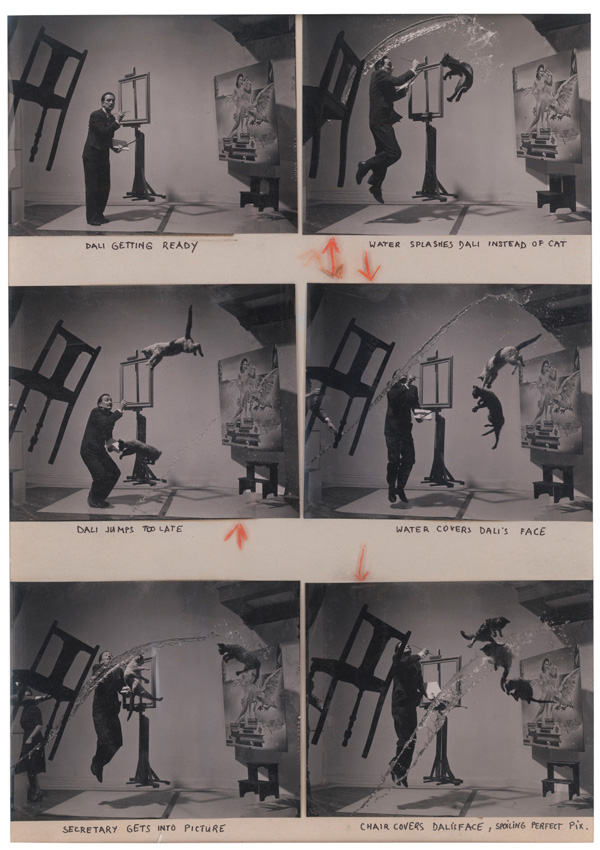
Salvador Dali, 1948. Phillipe Halsman/Magnum Photos
The narrative construction of time in the image
In photography, the artist chooses the setting, frame and significant object inside the visual narrative he or she wishes to convey. When actions or movement are directly involved, he or she chooses and captures the "decisive moment" in which the Barthesian punctum is unveiled, the point at which all the elements, signs and marks that lend meaning to the image are incorporated.
Photographic discourse, like many artistic languages, has a double spatiality and temporality: on the one hand, it constitutes a two-dimensional space [s1] that represents an illusory, three-dimensional space [s2]. On the other hand, there is the time of representation [t1] – that is, the real time when the photograph was taken –, and the time represented in the image [t2].
Time in a photograph is constructed by linking various elements that can be observed on different levels. These elements include rhythm, tension, sequentiality, the representation of duration and references to the definition of space.
The space and time of representation are fundamental elements of photographic composition: on the one hand perspective, depth of field, interplay of plans, balance, proportion, visual tour, iconic order, tension and rhythm; and on the other instantaneity, longevity, sequentiality, symbolic and subjective times and narrative. Perspective and various planes create perceptual gradients that construct the three-dimensional space and movement in the images. The rhythm is observed through the repetition of elements and the way they are organized in the composition. Saturation, empty spaces and the distribution of tones determine the pace of a photograph. Tension is created by various elements: the lines that express movement, the contrast between regular geometric shapes, the sweeps, angles, perspective, chromatic contrast, lighting and textures of the image. The visual weight of each of the elements, determined by their size and position in the different planes of the photographs, can provide a spatial-temporal hierarchy, whereby more important elements in the foreground are equivalent to the present in the narration of the image. The point of view is expressed through the field of vision, the angle from which the photograph is taken, and the selection of objects shown with clarity and closeness, or that remain in the middle ground or background. The photograph suggests a visual tour, a dynamic order of interpretation established by the composition that can indicate a timeline.
At a technical level, the time dimension is produced by the shutter speed. If the photographer wishes to project an instant, to freeze time, he or she will use a fast speed to capture a scene in a fraction of a second, which in literature would be depicted in a vignette. If, alternately, he or she wishes to depict duration, a low speed allows a long exposure times that create effects in the image, such as the sweep in a moving subject. The presence of certain elements such as clocks, calendars, old objects and even photographs are indicators of time that lead the viewer to interpret the image as duration or sequentiality. Some photographers prefer to convey the opposite, a timeless situation, and to do so deliberately conceal any mark that might indicate the historical time or moment when the photograph was taken. Erasing the traces of time is a discursive effect that has been used since classical representation and “is intended to strengthen the illusion of reality (Marzal Felici, 2011, p. 215).
However, an image can express much more than a fragment of reality. It can be a metaphor in itself, and its content may be symbolic, as will also be the time within it. In the case of abstract photographs, for example, in which spatio-temporal marks are concealed, their discourse is closer to poetry, with a necessarily individual interpretation. The perception of time and space within them is subjective. The Barthesian punctum relates to the presence of a subjective time, the element that bursts into the time flow of interpreting the image. It moves or affects the viewer at a very personal level, based on their previous experience.
Another aspect in which the time characteristics of a photograph can be analyzed is sequentiality1, both in its elements within a single image, [such as its order and layout], and in the succession of photographs in polyptychs depicting a sequential scene. The illustrative dimension of the image comprises the central elements of narrative: point of view, characters, authenticity, textual marks and enunciation.
The narrative of the image is constructed by the morphological, compositional and illustrative elements, which together convey a specific overall temporal effect. The point of view from which a story is narrated is crucial and, in photography, can be clearly observed in the framing, the position of the photographer and the angle from which it is taken [the result of selecting a determined space and time]. The framing evokes the artist’s way of looking and choosing which part of the world is worth stopping, closely observing and relating.
The characters in a photograph can say a great deal about the scene depicted: their emotions, feelings, attitudes and expectations, reflected in their posture, gestures and gaze, tell stories and show how they react to their surroundings. Authenticity and its opposite, artificiality [not to be confused with fictionality] in photography is constructed using certain effects, staging or filters or nothing at all, if the intention is to be faithful to the real scene, in accordance with the photographer’s narrative intention. If the aim is to create alienation, fracture or a concept in the viewer, they will distance the image from the parameters of reality by seeking to redefine its constituent elements. The textual marks reveal the presence of the enunciator in the image. These can be indicative, iconic, symbolic or referential marks. They include the internal organization of their elements, the tension between the geometric lines and figures, and the focus of attention. As Santos Zunzunegui wrote, quoted by Marzal2: “the presence of the viewer can be reconstructed and is therefore visible” (2011, p. 221), through two discursive activities: aspectualization [identifying a group of spatio-temporal aspectual categories that reveal the presence of the viewer; and focalization [how the photographic intent expresses itself].
Marzal identifies two strategies in photographic enunciation: on the one hand, the one applied in the realistic representation of discourse, a metonymic strategy in terms of language, in which the photographic discourse remains contiguous to the model; and on the other, the strategy that seeks a non-realistic, metaphorical representation, with an imaginary or symbolical relationship with the model. The caption often provides this information since without it, incorrect if at times interesting interpretations might emerge.
However, time may not only be observed in the content of the photograph, such as its objects and setting, but also be defined in each of the substantial stages of the photographic act, and may be explained by transferring the terms that Ricoeur (1995) uses for the textual narrative to the narrative of the image. 1. Prefiguration, a deeper exploration of the contextual level of analysis proposed by Marzal, refers to the circumstances and conditions in which the photograph is taken, the specific space, historical moment, technological development of the era and the author’s biography, among others. 2. Configuration is the process of producing the image using all the creative and technical elements that correspond to the morphological, compositional and illustrative levels. 3. Refiguration involves the viewers’ interpretation of the image, in other words, illustration and its reception. The process of narrating and interpreting time in the images takes place during these three moments of the photographic act.
However, when arranging the photographic piece or series, it is important that the different times be distinguished, since each one follows specific narrative strategies: 1. Objective time, defined by the precise moment at which the photograph was taken, is the referential time that is narrated on the basis of the textual marks in the image. 2 Represented time, shown in the photograph by the time frames that the photographer decides to include, is equivalent to the time of the story. 3. Symbolic time, when the image suggests a different reality to that represented, is constructed by creating ambiguity in meaning, or by recurring to visual rhetorical figures [such as metonymy, synechdoque and personification] or by the deliberate concealing of time frames. 4. Lastly, subjective time is determined by the point of view that the author applies to the image, but also by the context and interpretation of the viewer during the reconfiguration process. The latter two can be clearly seen in photographs created with artistic rather than documentary intentions, whose few referential elements make the images appear suspended in non-time. These photographs play with the viewer’s perception in order to elicit sensations, aesthetic emotions, uncertainty, or enable the latter to interpret and define its symbolic content and spatial-temporality.
1 Marzal Felice links sequentiality to narrative. However, here they are regarded as two separate processes as a broader concept of narrative is taken than the mere succession of events.
2 Much of the methodology proposed by Marzal is extracted from Santos Zunzunegui’s analysis in Paisajes de la forma. Ejercicios de análisis de la imagen. Cátedra, Madrid, 1988
Bibliografía
López Aguilar, E. (octubre de 2002). Julio Cortázar y la fotografía. La jornada semanal (397).
Bergson, H. (2007). La evolución creadora. Buenos Aires: Cactus.
Marzal Felici, J. (2011). Cómo se lee una fotografía. Madrid: Cátedra.
Ricoeur, P. (1995). Tiempo y narración (Vol. II). México: Siglo XXI.
 Mónica Sánchez Ezcuer. Lives and works in Mexico. Writer and literature professor. Sociologist at the UNAM with a master in Literary Creation from the University of Texas. Currently she studies the master Visual Arts at San Carlos (UNAM). She collaborates in multidisciplinary projects; she has worked with musicians, painters and photographers in realizing operas, publications, concerts and exhibitions. She is especially interested in the relation between photography and narrative. She has given courses and workshops in literature and narrative in various institutions, like the UNAM, the University of Texas, Casa Lamm and the Foundation Pedro Meyer.
Mónica Sánchez Ezcuer. Lives and works in Mexico. Writer and literature professor. Sociologist at the UNAM with a master in Literary Creation from the University of Texas. Currently she studies the master Visual Arts at San Carlos (UNAM). She collaborates in multidisciplinary projects; she has worked with musicians, painters and photographers in realizing operas, publications, concerts and exhibitions. She is especially interested in the relation between photography and narrative. She has given courses and workshops in literature and narrative in various institutions, like the UNAM, the University of Texas, Casa Lamm and the Foundation Pedro Meyer.Time is creation, argued Henri Bergson: “The more we explore the nature of time, the more we will understand how duration means invention, creation of forms and continuous production of the absolutely new.” (2007, p. 30).
Only insofar as time is perceived and received does it exist and acquire meaning for man. Photography and literature are two artistic media through which humanity has recreated duration and development. Both disciplines encapsulate instants: literature, a sequence of them, and photography a single instant that reveals or implies a before and an after. They capture time to show a legible fragment of its movement. Regardless of whether what they depict and relate is real or fiction, a text or a photograph bears the traces of the passage of time.
The two languages represent this passage through various forms and processes, based on the position, movement and speed of the observer-narrator, which can broadly be summarized in three moments: 1] stopped time: a literary vignette or frozen image of a scene in which the objects and/or characters are time frames depicting something that happened or is about to happen; 2] the visual tour from a fixed point: images or texts that draw the gaze or reading towards the various focal points of a panoramic photo or a written narrative, generally in the present, in which the narrator reveals to the reader the space-time in which the action takes place through descriptions; and 3] movement: where the actions of the story comprised in an objective period of time, including the stream of consciousness, are visually narrated and represented.
The reality described or depicted in photography and literature is not only an interpretation of the facts but also of their duration and the continuous movement of the story and the events contained in it. In both disciplines, time is a reference, structure and metaphor. It is a fundamental part of the framework of both media, and is also represented and reconfigured as an image of the expression of literary and photographic discourses. It cannot be explained or demonstrated: “The artist who works with photography or stories does not provide solutions, but rather answers people's questions with another question, a more refined, aesthetic one: a doubt answered with a metaphor.” (López Aguilar, 2002).

Salvador Dali, 1948. Phillipe Halsman/Magnum Photos
The narrative construction of time in the image
In photography, the artist chooses the setting, frame and significant object inside the visual narrative he or she wishes to convey. When actions or movement are directly involved, he or she chooses and captures the "decisive moment" in which the Barthesian punctum is unveiled, the point at which all the elements, signs and marks that lend meaning to the image are incorporated.
Photographic discourse, like many artistic languages, has a double spatiality and temporality: on the one hand, it constitutes a two-dimensional space [s1] that represents an illusory, three-dimensional space [s2]. On the other hand, there is the time of representation [t1] – that is, the real time when the photograph was taken –, and the time represented in the image [t2].
Time in a photograph is constructed by linking various elements that can be observed on different levels. These elements include rhythm, tension, sequentiality, the representation of duration and references to the definition of space.
The space and time of representation are fundamental elements of photographic composition: on the one hand perspective, depth of field, interplay of plans, balance, proportion, visual tour, iconic order, tension and rhythm; and on the other instantaneity, longevity, sequentiality, symbolic and subjective times and narrative. Perspective and various planes create perceptual gradients that construct the three-dimensional space and movement in the images. The rhythm is observed through the repetition of elements and the way they are organized in the composition. Saturation, empty spaces and the distribution of tones determine the pace of a photograph. Tension is created by various elements: the lines that express movement, the contrast between regular geometric shapes, the sweeps, angles, perspective, chromatic contrast, lighting and textures of the image. The visual weight of each of the elements, determined by their size and position in the different planes of the photographs, can provide a spatial-temporal hierarchy, whereby more important elements in the foreground are equivalent to the present in the narration of the image. The point of view is expressed through the field of vision, the angle from which the photograph is taken, and the selection of objects shown with clarity and closeness, or that remain in the middle ground or background. The photograph suggests a visual tour, a dynamic order of interpretation established by the composition that can indicate a timeline.
At a technical level, the time dimension is produced by the shutter speed. If the photographer wishes to project an instant, to freeze time, he or she will use a fast speed to capture a scene in a fraction of a second, which in literature would be depicted in a vignette. If, alternately, he or she wishes to depict duration, a low speed allows a long exposure times that create effects in the image, such as the sweep in a moving subject. The presence of certain elements such as clocks, calendars, old objects and even photographs are indicators of time that lead the viewer to interpret the image as duration or sequentiality. Some photographers prefer to convey the opposite, a timeless situation, and to do so deliberately conceal any mark that might indicate the historical time or moment when the photograph was taken. Erasing the traces of time is a discursive effect that has been used since classical representation and “is intended to strengthen the illusion of reality (Marzal Felici, 2011, p. 215).
However, an image can express much more than a fragment of reality. It can be a metaphor in itself, and its content may be symbolic, as will also be the time within it. In the case of abstract photographs, for example, in which spatio-temporal marks are concealed, their discourse is closer to poetry, with a necessarily individual interpretation. The perception of time and space within them is subjective. The Barthesian punctum relates to the presence of a subjective time, the element that bursts into the time flow of interpreting the image. It moves or affects the viewer at a very personal level, based on their previous experience.
Another aspect in which the time characteristics of a photograph can be analyzed is sequentiality1, both in its elements within a single image, [such as its order and layout], and in the succession of photographs in polyptychs depicting a sequential scene. The illustrative dimension of the image comprises the central elements of narrative: point of view, characters, authenticity, textual marks and enunciation.
The narrative of the image is constructed by the morphological, compositional and illustrative elements, which together convey a specific overall temporal effect. The point of view from which a story is narrated is crucial and, in photography, can be clearly observed in the framing, the position of the photographer and the angle from which it is taken [the result of selecting a determined space and time]. The framing evokes the artist’s way of looking and choosing which part of the world is worth stopping, closely observing and relating.
The characters in a photograph can say a great deal about the scene depicted: their emotions, feelings, attitudes and expectations, reflected in their posture, gestures and gaze, tell stories and show how they react to their surroundings. Authenticity and its opposite, artificiality [not to be confused with fictionality] in photography is constructed using certain effects, staging or filters or nothing at all, if the intention is to be faithful to the real scene, in accordance with the photographer’s narrative intention. If the aim is to create alienation, fracture or a concept in the viewer, they will distance the image from the parameters of reality by seeking to redefine its constituent elements. The textual marks reveal the presence of the enunciator in the image. These can be indicative, iconic, symbolic or referential marks. They include the internal organization of their elements, the tension between the geometric lines and figures, and the focus of attention. As Santos Zunzunegui wrote, quoted by Marzal2: “the presence of the viewer can be reconstructed and is therefore visible” (2011, p. 221), through two discursive activities: aspectualization [identifying a group of spatio-temporal aspectual categories that reveal the presence of the viewer; and focalization [how the photographic intent expresses itself].
Marzal identifies two strategies in photographic enunciation: on the one hand, the one applied in the realistic representation of discourse, a metonymic strategy in terms of language, in which the photographic discourse remains contiguous to the model; and on the other, the strategy that seeks a non-realistic, metaphorical representation, with an imaginary or symbolical relationship with the model. The caption often provides this information since without it, incorrect if at times interesting interpretations might emerge.
However, time may not only be observed in the content of the photograph, such as its objects and setting, but also be defined in each of the substantial stages of the photographic act, and may be explained by transferring the terms that Ricoeur (1995) uses for the textual narrative to the narrative of the image. 1. Prefiguration, a deeper exploration of the contextual level of analysis proposed by Marzal, refers to the circumstances and conditions in which the photograph is taken, the specific space, historical moment, technological development of the era and the author’s biography, among others. 2. Configuration is the process of producing the image using all the creative and technical elements that correspond to the morphological, compositional and illustrative levels. 3. Refiguration involves the viewers’ interpretation of the image, in other words, illustration and its reception. The process of narrating and interpreting time in the images takes place during these three moments of the photographic act.
However, when arranging the photographic piece or series, it is important that the different times be distinguished, since each one follows specific narrative strategies: 1. Objective time, defined by the precise moment at which the photograph was taken, is the referential time that is narrated on the basis of the textual marks in the image. 2 Represented time, shown in the photograph by the time frames that the photographer decides to include, is equivalent to the time of the story. 3. Symbolic time, when the image suggests a different reality to that represented, is constructed by creating ambiguity in meaning, or by recurring to visual rhetorical figures [such as metonymy, synechdoque and personification] or by the deliberate concealing of time frames. 4. Lastly, subjective time is determined by the point of view that the author applies to the image, but also by the context and interpretation of the viewer during the reconfiguration process. The latter two can be clearly seen in photographs created with artistic rather than documentary intentions, whose few referential elements make the images appear suspended in non-time. These photographs play with the viewer’s perception in order to elicit sensations, aesthetic emotions, uncertainty, or enable the latter to interpret and define its symbolic content and spatial-temporality.
1 Marzal Felice links sequentiality to narrative. However, here they are regarded as two separate processes as a broader concept of narrative is taken than the mere succession of events.
2 Much of the methodology proposed by Marzal is extracted from Santos Zunzunegui’s analysis in Paisajes de la forma. Ejercicios de análisis de la imagen. Cátedra, Madrid, 1988
Bibliografía
López Aguilar, E. (octubre de 2002). Julio Cortázar y la fotografía. La jornada semanal (397).
Bergson, H. (2007). La evolución creadora. Buenos Aires: Cactus.
Marzal Felici, J. (2011). Cómo se lee una fotografía. Madrid: Cátedra.
Ricoeur, P. (1995). Tiempo y narración (Vol. II). México: Siglo XXI.
 Mónica Sánchez Ezcuer. Lives and works in Mexico. Writer and literature professor. Sociologist at the UNAM with a master in Literary Creation from the University of Texas. Currently she studies the master Visual Arts at San Carlos (UNAM). She collaborates in multidisciplinary projects; she has worked with musicians, painters and photographers in realizing operas, publications, concerts and exhibitions. She is especially interested in the relation between photography and narrative. She has given courses and workshops in literature and narrative in various institutions, like the UNAM, the University of Texas, Casa Lamm and the Foundation Pedro Meyer.
Mónica Sánchez Ezcuer. Lives and works in Mexico. Writer and literature professor. Sociologist at the UNAM with a master in Literary Creation from the University of Texas. Currently she studies the master Visual Arts at San Carlos (UNAM). She collaborates in multidisciplinary projects; she has worked with musicians, painters and photographers in realizing operas, publications, concerts and exhibitions. She is especially interested in the relation between photography and narrative. She has given courses and workshops in literature and narrative in various institutions, like the UNAM, the University of Texas, Casa Lamm and the Foundation Pedro Meyer.Alvaro Deprit

At home I always used to linger with curiosity at an old photograph of some of my Andalusian relatives. With the passing of years this photograph has given me an image of how I think Andalusia might be.
Al-Andalus is the result of approximately three years of research in the south of Spain, an area I did not know nor in which I have lived, but which is my family’s place of origin and current place of residence.
My initial interest was in the tension I perceived between tradition and the marks of the global world. Andalusia is the result of a complex cultural stratification, derived from the passage of civilisations which, over time, gave life to a hybrid identity capable of containing within it the stereotypical traits of Spanish culture.
Journeying through Andalusia now that it has been hit hard by the economic crisis has made me reflect on the collision of the diverse elements in this land – a land which, as I see it, has shown itself to be hanging in the balance, almost in a state between reality and fiction as the background of a movie.
My intention has not been to reproduce the tangible aspects of a place, but to give shape to a body of memories and impressions born of my personal history or of something unconcluded. Concentrated in the images are visible apparitions whose existence is a mystery, while on the other hand, the mystery is something real in the mind, through the repeating, varying, developing and transposing elements of the memory.
































 Alvaro Deprit (Madrid). Has been living in Italy since 2004. He studied German Philology at the Complutense University of Madrid and at the Otto Friedrich University of Bamberg, Germany. He also studied Sociology at the University d’Annunzio in Chieti, Italy. Alvaro’s work has been exhibited in festivals and galleries all over the world and has been published in international magazines. He won the PHotoEspaña OjodePez Human Values Award, the BJP’s International Photography Award and the Viewbook Photostory Contest, and he was a finalist in Voies Off Arles, Leica Oskar Barnack Award and Sony Award.
Alvaro Deprit (Madrid). Has been living in Italy since 2004. He studied German Philology at the Complutense University of Madrid and at the Otto Friedrich University of Bamberg, Germany. He also studied Sociology at the University d’Annunzio in Chieti, Italy. Alvaro’s work has been exhibited in festivals and galleries all over the world and has been published in international magazines. He won the PHotoEspaña OjodePez Human Values Award, the BJP’s International Photography Award and the Viewbook Photostory Contest, and he was a finalist in Voies Off Arles, Leica Oskar Barnack Award and Sony Award.
At home I always used to linger with curiosity at an old photograph of some of my Andalusian relatives. With the passing of years this photograph has given me an image of how I think Andalusia might be.
Al-Andalus is the result of approximately three years of research in the south of Spain, an area I did not know nor in which I have lived, but which is my family’s place of origin and current place of residence.
My initial interest was in the tension I perceived between tradition and the marks of the global world. Andalusia is the result of a complex cultural stratification, derived from the passage of civilisations which, over time, gave life to a hybrid identity capable of containing within it the stereotypical traits of Spanish culture.
Journeying through Andalusia now that it has been hit hard by the economic crisis has made me reflect on the collision of the diverse elements in this land – a land which, as I see it, has shown itself to be hanging in the balance, almost in a state between reality and fiction as the background of a movie.
My intention has not been to reproduce the tangible aspects of a place, but to give shape to a body of memories and impressions born of my personal history or of something unconcluded. Concentrated in the images are visible apparitions whose existence is a mystery, while on the other hand, the mystery is something real in the mind, through the repeating, varying, developing and transposing elements of the memory.
































 Alvaro Deprit (Madrid). Has been living in Italy since 2004. He studied German Philology at the Complutense University of Madrid and at the Otto Friedrich University of Bamberg, Germany. He also studied Sociology at the University d’Annunzio in Chieti, Italy. Alvaro’s work has been exhibited in festivals and galleries all over the world and has been published in international magazines. He won the PHotoEspaña OjodePez Human Values Award, the BJP’s International Photography Award and the Viewbook Photostory Contest, and he was a finalist in Voies Off Arles, Leica Oskar Barnack Award and Sony Award.
Alvaro Deprit (Madrid). Has been living in Italy since 2004. He studied German Philology at the Complutense University of Madrid and at the Otto Friedrich University of Bamberg, Germany. He also studied Sociology at the University d’Annunzio in Chieti, Italy. Alvaro’s work has been exhibited in festivals and galleries all over the world and has been published in international magazines. He won the PHotoEspaña OjodePez Human Values Award, the BJP’s International Photography Award and the Viewbook Photostory Contest, and he was a finalist in Voies Off Arles, Leica Oskar Barnack Award and Sony Award.Zone Zero
Andy Joule uses a combination of traditional and digital techniques, such as stop-motion, multi-layered image sequences and time-lapse. His time-lapses are more than just a technical sensation, closer to the fields of experimental video or fictional documentary. Time becomes the protagonist. Objects that seem to be inert at first, begin to change; a process that only becomes visible by the layer of time that is put over the presented sequences. In this way, the work of Joule brings about the manipulation, deconstruction and reinterpretation of time and space, proposing unconventional narratives and new ways of understanding time in short audiovisual formats.
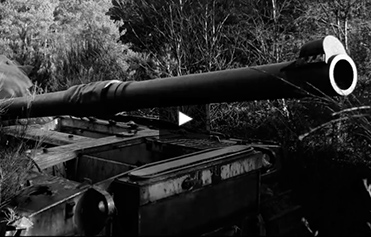 SALVAGE
SALVAGEInspired by a quote from the naturalist Jacques Yves Cousteau, this film explores the way in which nature clings to life, finds a foothold, and ultimately reclaims what is hers. The solidity of these metal beasts is questioned as the rust and flake slowly leak into the ground.
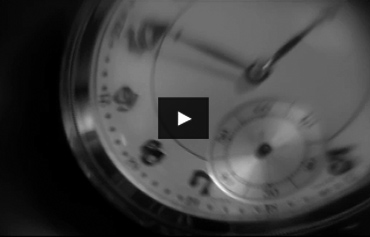 ELIPSIS
ELIPSIS Andy Joule is a film-maker and animator. He studied animation at West Surrey College of Art & Design. After graduating he worked in London, Manchester, Bristol, the Netherlands and in the US. His films have been screened in festivals and competitions around the world. He has lectured at Volda University College, Norway and is a Senior Lecturer in Animation at the University for the Creative Arts. He is also a BAFTA juror and a Fellow of the Royal Society of Arts.
Andy Joule is a film-maker and animator. He studied animation at West Surrey College of Art & Design. After graduating he worked in London, Manchester, Bristol, the Netherlands and in the US. His films have been screened in festivals and competitions around the world. He has lectured at Volda University College, Norway and is a Senior Lecturer in Animation at the University for the Creative Arts. He is also a BAFTA juror and a Fellow of the Royal Society of Arts.Andy Joule uses a combination of traditional and digital techniques, such as stop-motion, multi-layered image sequences and time-lapse. His time-lapses are more than just a technical sensation, closer to the fields of experimental video or fictional documentary. Time becomes the protagonist. Objects that seem to be inert at first, begin to change; a process that only becomes visible by the layer of time that is put over the presented sequences. In this way, the work of Joule brings about the manipulation, deconstruction and reinterpretation of time and space, proposing unconventional narratives and new ways of understanding time in short audiovisual formats.
 SALVAGE
SALVAGEInspired by a quote from the naturalist Jacques Yves Cousteau, this film explores the way in which nature clings to life, finds a foothold, and ultimately reclaims what is hers. The solidity of these metal beasts is questioned as the rust and flake slowly leak into the ground.
 ELIPSIS
ELIPSIS Andy Joule is a film-maker and animator. He studied animation at West Surrey College of Art & Design. After graduating he worked in London, Manchester, Bristol, the Netherlands and in the US. His films have been screened in festivals and competitions around the world. He has lectured at Volda University College, Norway and is a Senior Lecturer in Animation at the University for the Creative Arts. He is also a BAFTA juror and a Fellow of the Royal Society of Arts.
Andy Joule is a film-maker and animator. He studied animation at West Surrey College of Art & Design. After graduating he worked in London, Manchester, Bristol, the Netherlands and in the US. His films have been screened in festivals and competitions around the world. He has lectured at Volda University College, Norway and is a Senior Lecturer in Animation at the University for the Creative Arts. He is also a BAFTA juror and a Fellow of the Royal Society of Arts.

